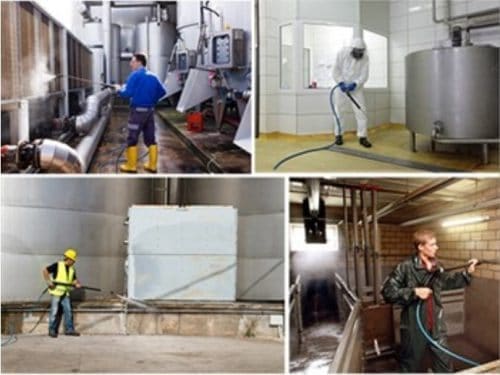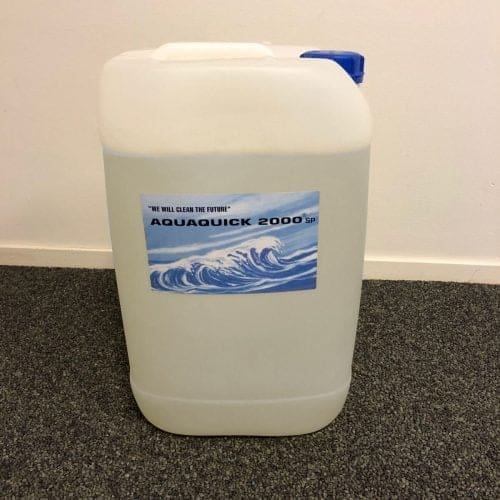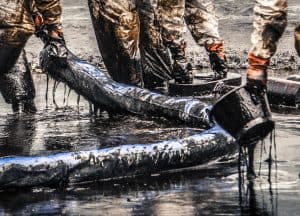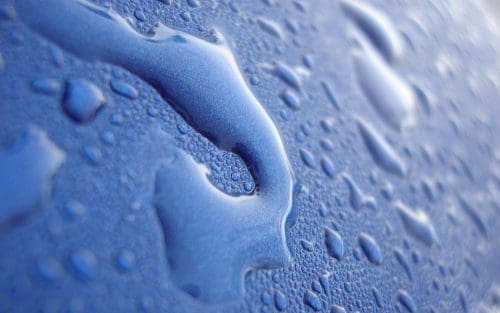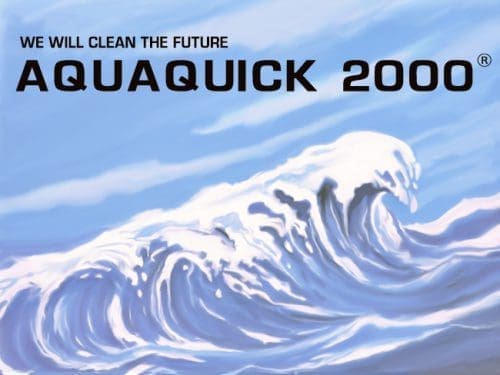Oil spills are catastrophic events that demand immediate and effective action to mitigate environmental damage and it requires oil spill cleanup. There are several methods for oil spill cleanup, each with its own advantages and limitations. This article discusses the most commonly used methods to oil spill cleanup at sea, focusing on techniques such as oil booms, skimmers, and sorbents.
1. Oil Booms
Oil booms are large devices used to contain and collect spilled oil, making them a primary tool in oil spill cleanup response. These barriers float on the water’s surface and prevent the spread of oil, allowing for easier recovery. Oil booms come in various sizes and designs tailored to different types of spills and water conditions. For instance, inflatable booms can be quickly deployed in emergencies, while permanent booms are used in high-risk areas like harbors and oil terminals.
The material used for the boom’s construction is also critical; robust materials like PVC or rubberized fabric ensure durability and effectiveness. Maintenance of oil booms involves regular inspections and cleaning to prevent degradation and ensure they function correctly during a spill.
Components of Oil Booms:
- Freeboard: The part of the boom that rises above the water surface, trapping the oil.
- Skirt: Positioned below the water surface, the skirt acts as a barrier wall, preventing oil from escaping underneath.
- Chain/Cable: Connects and stabilizes the boom, ensuring it remains effective in containing the spill.
Usage and Limitations:
Oil booms are particularly useful in calm waters and confined areas. However, they are less effective in rough seas, strong winds, and fast currents. Their effectiveness diminishes with larger spills, as more oil can escape containment.
2. Sorbents
Sorbents are materials that absorb or adsorb liquids, making them effective for oil spill cleanup. They can be classified into two types: absorbents and adsorbents. The choice between natural and synthetic sorbents depends on the specific spill scenario. Natural sorbents are biodegradable and environmentally friendly but have lower absorption capacities.
Synthetic sorbents, on the other hand, offer higher efficiency and can be reused, which is cost-effective in the long run. The deployment of sorbents must consider the retrieval and disposal process to prevent secondary pollution. Innovations in sorbent technology continue to improve their efficacy and environmental impact, such as developing sorbents that can be easily collected and reprocessed.
Types of Sorbents:
- Absorbents: Soak up oil, much like a sponge. Common absorbents include straw, corncob, and peat moss, which are organic but less efficient.
- Adsorbents: Do not soak up oil but form a layer on the surface. Synthetic materials, such as polyurethane foam, can absorb up to 90 times their weight and are reusable.
Usage and Limitations:
While sorbents are effective for small spills and localized areas, they can be difficult to retrieve once saturated. In some cases, they may sink under their own weight, posing risks to aquatic life.
3. Skimmers
Skimmers are mechanical devices used to remove oil from the water’s surface. Mounted on boats, they work by sucking up the oil and separating it from the water. There are various types of skimmers, including weir skimmers, oleophilic skimmers, and vacuum skimmers. Weir skimmers use a dam-like structure to skim the oil from the surface, while oleophilic skimmers use oil-attracting materials to collect the oil.
Vacuum skimmers suck the oil directly from the water surface. Each type has its specific applications, strengths, and weaknesses. For example, oleophilic skimmers are particularly effective in thick oil spill cleanup, while vacuum skimmers are suitable for thin layers of oil. Skimmers require regular maintenance and calibration to ensure optimal performance during an oil spill cleanup response.
Advantages:
- Can separate and recover reusable oil.
- Effective in removing oil from the water surface.
Limitations:
Skimmers can become clogged with debris, reducing their efficiency. They are best used in calm waters and are less effective in rough seas or in the presence of large amounts of debris.
4. High-Pressure Washing
High-pressure washing involves spraying hot water at high pressure to flush oil from surfaces. This method is primarily used on shorelines where oil is trapped and inaccessible to larger machinery. The use of high-pressure washing must be carefully managed to avoid environmental damage. The pressure and temperature of the water must be controlled to prevent erosion and thermal shock to local flora and fauna.
Additionally, the wastewater produced must be collected and treated to remove oil residues before being released back into the environment. High-pressure washing is often part of a combined oil spill cleanup approach, used in conjunction with skimmers and sorbents to manage the dispersed oil effectively. Training and protective equipment for personnel are essential to ensure safety during the operation.
Advantages:
- Effective in removing oil from rocky shores and other hard-to-reach areas.
Limitations:
High-pressure washing can disperse oil into the water, potentially contaminating clean areas and harming marine life. It is not suitable for open sea oil spill cleanup.
5. In-Situ Burning
In-situ burning involves igniting the oil on the water’s surface to burn it off. This method was notably used during the Deepwater Horizon oil spill cleanup in the Gulf of Mexico in 2010. The success of in-situ burning depends on several factors, including the type of oil, weather conditions, and the presence of emulsified oil.
The method also generates air pollution, including soot and toxic fumes, which must be monitored to protect public health and the environment. Regulatory approvals are often required before in-situ burning can be conducted, and it must be part of a comprehensive oil spill response plan. Advances in in-situ burning techniques aim to increase efficiency and reduce the environmental impact of the emissions produced.
Advantages:
- Can remove up to 98% of oil from the water surface.
- Rapid and effective under suitable conditions.
Limitations:
In-situ burning requires a minimum oil thickness of 3 mm and favorable weather conditions. It cannot be used for thinner oil layers or during adverse weather.
6. Gelatin Treatment
Gelatinizing agents are applied in powdered form to oil spills, creating a solid gelatin that separates the oil from water. The oil-gelatin compound can then be collected using nets and skimmers. The application of gelatinizing agents requires careful calculation to ensure the right amount is used, minimizing waste and environmental impact.
The collected oil-gelatin compound must be properly disposed of or treated to recover usable oil. This method is particularly useful for small to medium-sized spills and in areas where other methods are less effective. Research into more efficient and environmentally friendly gelatinizing agents continues, aiming to improve the practicality and effectiveness of this method in larger spill scenarios.
Advantages:
- Effective in solidifying and removing oil from water.
Limitations:
The ratio of gelatin to oil is 3:1, making this method impractical for large spills due to the sheer amount of gelatin required.
7. Bioremediation
Bioremediation uses microorganisms, such as bacteria, algae, and fungi, to break down oil into simpler, non-toxic molecules. This method leverages the natural metabolic processes of these organisms. Bioremediation can be conducted in situ (at the site of the spill) or ex situ (after removing the contaminated material). In situ bioremediation is less disruptive and maintains the natural habitat, but it may take longer to see results.
Ex situ bioremediation allows for more controlled conditions, potentially speeding up the process. The success of bioremediation depends on factors like temperature, nutrient availability, and oxygen levels. The use of genetically engineered microorganisms is an area of ongoing research, aiming to enhance the efficiency of bioremediation in various environmental conditions.
Advantages:
- Environmentally friendly and sustainable.
- Can be enhanced with reagents and fertilizers to promote microbial growth.
Limitations:
Bioremediation is a slower process compared to other methods and is more effective for long-term clean-up rather than immediate response. The effectiveness depends on the specific environmental conditions and the types of microorganisms used.
Understanding Oil Spill Cleanup

AQUAQUICK 2000 is a specialized product designed to address the challenging and environmentally critical issue of oil spill cleanup. In the realm of environmental disasters, oil spills pose significant threats to marine and coastal ecosystems, often necessitating swift and effective response measures to mitigate their impact. This product plays a crucial role in such scenarios, offering a solution that combines efficacy with environmental responsibility.
Oil spills occur when petroleum or its derivatives are accidentally released into the environment, typically in water bodies such as oceans, seas, or lakes. These spills can have devastating consequences for marine life, seabirds, coastal vegetation, and human health. Oil spill cleanup efforts are therefore essential to minimize ecological damage and restore affected areas to their natural state.
Challenges in Oil Spill Cleanup
Oil spill cleanup presents several challenges. Firstly, petroleum products are notoriously persistent in the environment, clinging to surfaces and resisting natural degradation processes. This persistence increases the difficulty of removing oil from affected areas effectively. Additionally, the scale of oil spills can vary greatly, from small localized incidents to large-scale catastrophes involving millions of gallons of oil.
Secondly, the environmental impact of traditional cleanup methods, such as chemical dispersants or mechanical containment and skimming, can be significant. These methods may introduce additional pollutants or disrupt ecosystems during cleanup operations, underscoring the need for environmentally friendly alternatives like AQUAQUICK 2000 for oil spill cleanup.
AQUAQUICK 2000: The Best Oil Spill Clean Up Solution
AQUAQUICK 2000 is a biodegradable and eco-friendly cleaning agent specifically formulated for use in oil spill cleanup and remediation efforts. Its effectiveness lies in its ability to break down and emulsify hydrocarbons like oil, facilitating their removal from various surfaces without causing further harm to the environment.
Key Features and Benefits
- Biodegradability: AQUAQUICK 2000 is designed to break down naturally over time, minimizing its environmental footprint compared to traditional chemical cleaners.
- Versatility: It can be used across different types of surfaces and environments affected by oil spills, including water bodies, shorelines, and industrial facilities.
- Efficiency: The product works quickly to emulsify oil, allowing for faster cleanup operations and reducing the overall impact of the spill on affected ecosystems.
- Safety: AQUAQUICK 2000 is formulated to be safe for use around wildlife and marine organisms, helping to protect fragile ecosystems during oil spill cleanup activities.
- Regulatory Compliance: It meets stringent environmental regulations, ensuring that cleanup efforts are conducted in accordance with legal standards.
Application in Oil Spill Cleanup
When an oil spill occurs, swift action is crucial to contain and mitigate its spread. AQUAQUICK 2000 is applied using specialized equipment or manually sprayed onto affected surfaces for oil spill cleanup. Upon contact with the oil, the product begins to emulsify and break down the hydrocarbons, reducing their adhesion to surfaces and facilitating easier removal.
Step-by-Step Cleanup Process:
- Assessment: Evaluate the extent and nature of the oil spill to determine the appropriate quantity of AQUAQUICK 2000 needed and the most effective application method.
- Application: Apply the product directly to the oil slick or contaminated surfaces using spray equipment or other suitable application methods.
- Emulsification: Allow AQUAQUICK 2000 sufficient time to emulsify the oil, typically within minutes to hours depending on the thickness and composition of the spill.
- Removal: Use mechanical means such as skimmers, absorbent materials, or vacuum equipment to collect the emulsified oil for proper disposal or recycling.
- Monitoring and Follow-up: Monitor the cleanup progress and conduct follow-up assessments to ensure that all oil residues are effectively removed and environmental impacts are minimized.
Environmental Impact and Sustainability
The environmental impact of oil spills extends far beyond immediate cleanup efforts. By using AQUAQUICK 2000, oil spill cleanup crews can minimize disruption to sensitive ecosystems and reduce the long-term environmental consequences of spills. The product’s biodegradable formulation ensures that residual chemicals do not persist in the environment, supporting ecological recovery and sustainability efforts.
Case Studies and Success Stories
Numerous case studies demonstrate the efficacy of AQUAQUICK 2000 in real-world oil spill cleanup scenarios. From coastal spills affecting marine habitats to industrial accidents in inland waterways, the product has been instrumental in restoring affected areas and minimizing ecological damage. These success stories underscore its value as a reliable tool in the arsenal of oil spill response and remediation strategies worldwide.
Conclusion
In conclusion, AQUAQUICK 2000 represents a significant advancement in the field of oil spill cleanup technology. Its biodegradable formulation, combined with effective emulsification properties, makes it a preferred choice for environmental agencies, oil spill cleanup contractors, and industries tasked with responding to oil spill cleanup. By utilizing AQUAQUICK 2000, stakeholders can not only expedite oil spill cleanup operations but also uphold their commitment to environmental stewardship and sustainability in the face of ecological challenges posed by oil spills.
Oil spill cleanup requires a combination of methods tailored to the specific circumstances of each spill. While tools like oil booms and skimmers provide immediate containment and recovery, methods like bioremediation offer long-term environmental remediation. Understanding the advantages and limitations of each technique is crucial for effective oil spill response and minimizing ecological impact.



